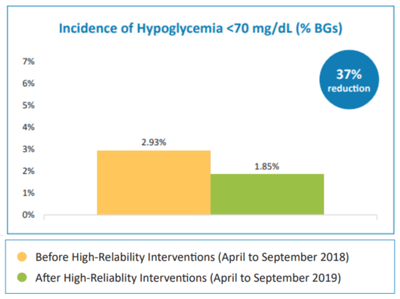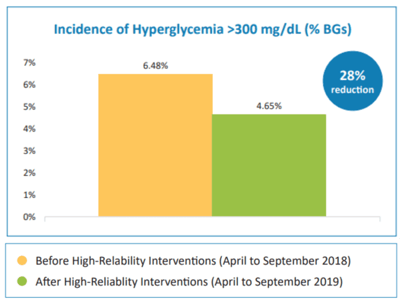Improved Glycemic Control in the Hospital Using Computer-Driven eGlycemic Management System® Plus High-Reliability Strategies for Basal Bolus Subcutaneous Insulin Therapy
Presentation
Diabetes Technology Society (DTS) Virtual Poster Meeting
Date
June 18, 2020
Authors
H. Courtenay Harrison, Jr., MD, Susan DeAbate, RN, MSN/ED, CDE, Tim Pike, MD, Peggy Braun, RN, BSN, MHA, CENP, Angel Harper-Clarke, BSN, RN, CMSRN, Jordan Messler, MD, SFHM
OBJECTIVE
Improve standardization of glycemic management for hospitalized patients requiring subcutaneous insulin therapy and increase utilization of basal bolus versus sliding scale regimens. Secondarily, reduce incidence of hypoglycemia and hyperglycemia.
METHOD
Sentara Virginia Beach General Hospital, a 276-bed community hospital in Virginia Beach, Virginia, sought to further capitalize on the computer-driven eGlycemic Management System® (eGMS®)* concurrent to other high-reliability strategies. A multidisciplinary Glycemic Management Committee and Glycemic Collaboration Committee were formed to provide overarching governance and facilitate change management. Representatives from administration, medical staff, nursing, diabetes education, pharmacy and information technology participated.
KEY INTERVENTIONS INCLUDED:
- Redesign and consolidation of insulin order sets for enhanced clarity and simplification
- Role-based education to nurses and physicians, including mandatory sessions for new staff
- Real-time monitoring of all insulin-requiring patients managed on eGMS®
- Nurse-driven process allowing for automatic insulin order initiation in response to hyperglycemia
- eGMS® super users within each unit to answer questions and provide one-on-one assistance
A retrospective analysis of performance and quality improvement outcomes was performed comparing six months of data before the interventions were initiated (April to September 2018)
to six months of data after the interventions were initiated (April to September 2019).
*eGlycemic Management System® is a registered trademark of Glytec, LLC on behalf of Aseko, Inc. All Rights Reserved.
RESULT
The number of hospitalized patients treated using eGMS® for basal bolus insulin therapy increased 366%, from an average of 44 per month before the high-reliability interventions were initiated to an average of 205 per month after the interventions were initiated.
Incidence of hypoglycemia measured as a percent of total blood glucose values <40 mg/dL decreased 47%, from an average of 0.17% before the high-reliability interventions were initiated to an average of 0.09% after the interventions were initiated; likewise, incidence of hypoglycemia measured as a percent of total blood glucose values <70 mg/dL decreased 37%, from an average of 2.93% to an average of 1.85%. Incidence of severe hyperglycemia measured as a percent of total blood glucose values >300 mg/dL decreased 28%, from an average of 6.48% to an average of
4.65%. The rate of in-target blood glucose values 70-180 mg/dL increased nearly 7%, from an average of 57.47% to an average of 61.28%.
CONCLUSIONS
High-reliability strategies coupled with a technology-enabled approach to glycemic management are effective in standardizing care, increasing utilization of basal bolus regimens for subcutaneous insulin therapy, and reducing hypoglycemia and hyperglycemia.
References
- Harrison Jr. H, DeAbate S, Pike T, Braun P, Harper-Clarke A, Messler J. Improved Glycemic Control in the Hospital Using Computer-Driven eGlycemic Management System® Plus High-Reliability Strategies for Basal Bolus Subcutaneous Insulin Therapy. DTS Virtual Poster Meeting. June 18, 2020.
ECO #0849-A



